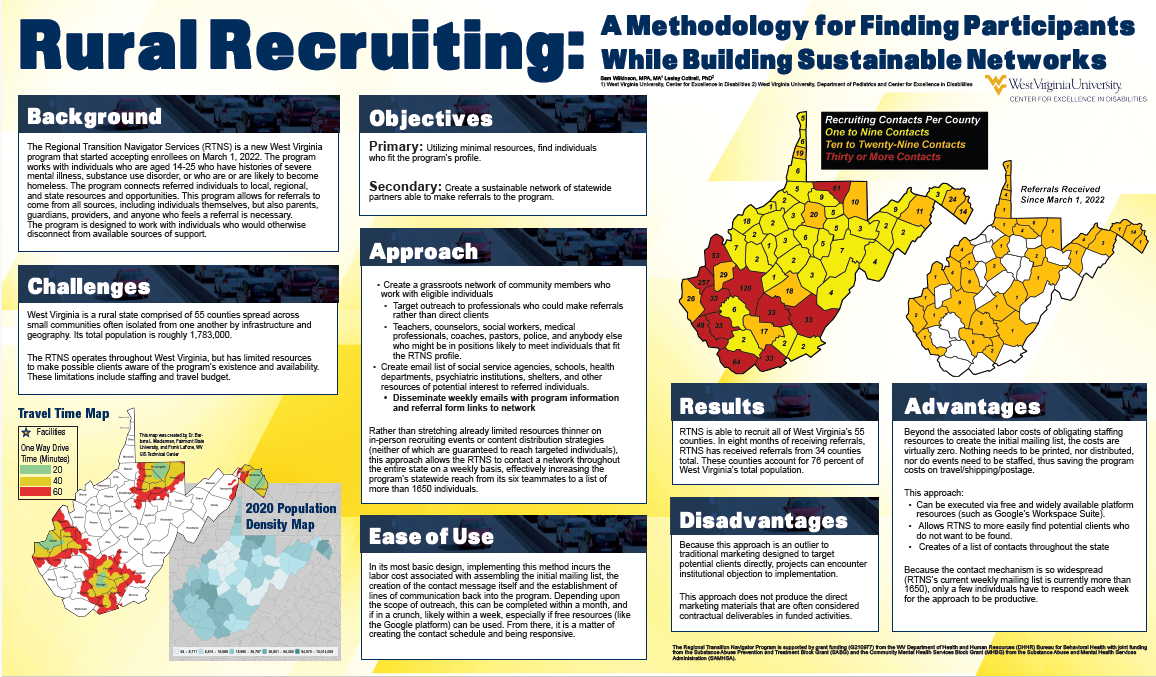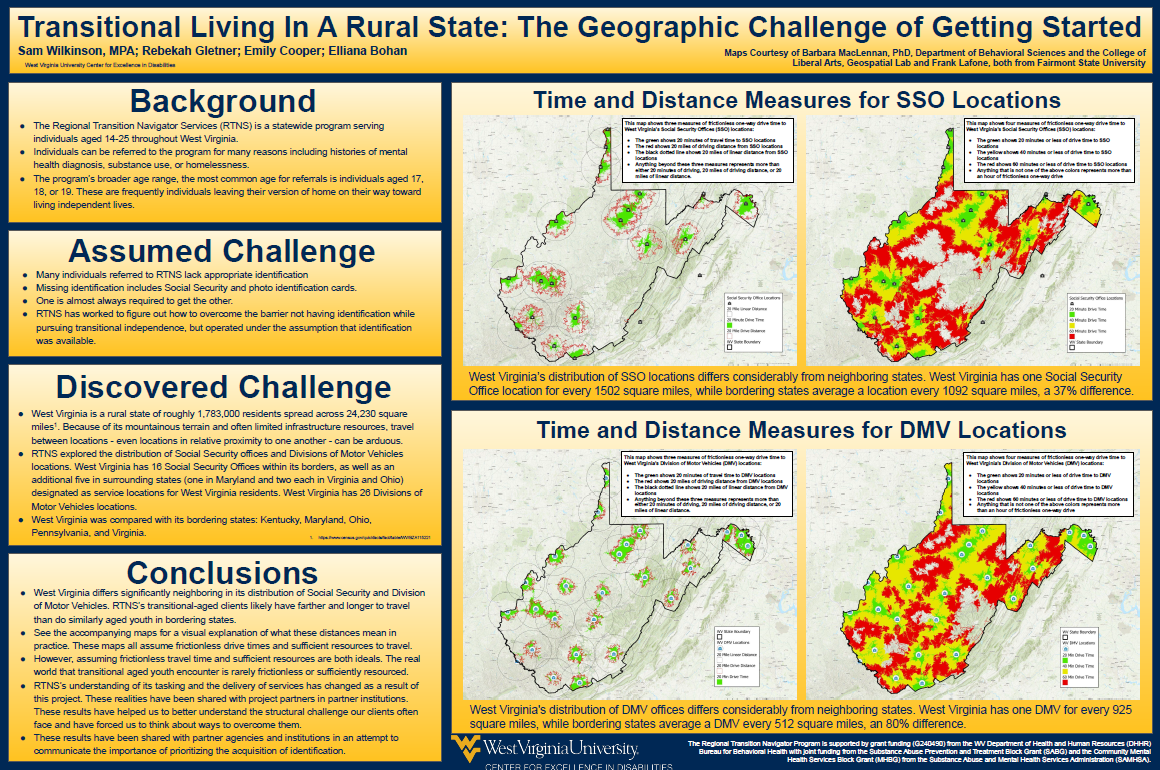Resources for Researchers
ClinicalTrial.Gov
ClinicalTrials.gov is a website and online database of clinical research studies and information about their results. The purpose of ClinicalTrials.gov is to provide information about clinical research studies to the public, researchers, and health care professionals. The U.S. government does not review or approve the safety and science of all studies listed on this website.
Quick instructions:
- Go to https://clinicaltrials.gov
- Be as general or as specific in your search of disability, interventions, or outcomes of interest to you.
- Search by locations (West Virginia, particular county)
- Use other filters if the number of trials continues to be high.
Participatory Research
Research can incorporate the community and/or population of focus as little or as much as desired. While studies have been conducted without input from the target population, guidelines have increasingly recommended incorporating the community in as many phases as possible (from start to finish). Thus, including individuals with disabilities in one’s research project is important as a member of the team, in the development and design of the study, when capturing information, analyzing that information, and then when interpreting the results.
This is not always possible but resources are becoming increasingly available to overcome challenges that keep individuals with disabilities and our larger communities out of the room.

*Image from Unified Equity Framework Establishing Service Equity within ODHS Service Delivery
LeMont Boyd, M.S.W. Race & Equity Transformation Manager
Oregon Department of Human Services
Articles illustrating community involvement in research
- How Can Research Better Represent People with Disabilities?
- Guidance for conducting collaborative research with people with disabilities
- The Use of Community Engaged Research Principles to Improve Health: Community Academic Partnerships for Research
- How to Overcome Common Barriers to Community Engagement
Students and Researchers
Resources in this section are designed and organized for students and other learners, individuals who are developing their first research project, and individuals who have been conducting research for some time. These materials are meant to help connect you with other researchers, their work, and resources that may be helpful for addressing common research challenges.
Lunch and Learns:
These are quick tutorials related to research development and design, implementation, analyses, and dissemination.
Common Challenges and Potential Solutions
Don’t let a setback in research keep you from reaching your goals. The information in this section reviews common challenges, compares potential solutions, and provides resources for getting past that setback.
Scammers and Survey Research
Survey research has been an efficient and effective way of capturing information from different audiences in both research and program evaluation. Unfortunately, on-line surveys that are shared on social media have increasingly been a focus of bots and “fake participants” or “scammers”. These individuals and developed programs can find survey opportunities across the globe and respond to a significant volume of surveys in a short period of time. This rising challenge is largely in response to surveys that offer some type of incentive (big or small) once the survey is completed.
Researchers have made several different attempts to prevent fake responses over time and must stay vigilant as bots and scammers continue to change their approaches to avoid being caught. Guidelines and recommendations are limited for researchers to find and use in their surveys to prevent these fake results. We have combined information from several sources into this section to provide a collection of potential solutions to this problem.
Before You Begin
- Add a captcha question at the beginning of the survey. This will help detect a bot’s response.
- Enable fraud detection features within the software you are using.
- Add a question that is hidden from humans but one that bots can detect. If this question is answered, you screen them out. For instance, add an optional single-choice question (checkbox) such as “Are you a human? [ ] Yes”. Add JavaScript to that question by replacing the existing Qualtrics.SurveyEngine.addOnload function and then preview the survey to check the question is hidden when the page loads. Qualtrics.SurveyEngine.addOnload(function() { jQuery("#"+this.questionId).hide(); });
- Add a required question that assesses attention and logic. For instance, “Which year is it?”
- Add illogical options to multiple-choice questions. For example, “Which of these services are you seeking? Choose an option that does not make sense to you.
- Ask one required question again later in the survey. Do not do this often as a human respondent will quickly get aggravated at this. One question, repeated once, like “Job Title"
- When you have inserted one or more of these question types, go to the settings for the survey and choose screening out options that will allow you to remove any entries that fit a particular response.
- Consider an additional step in your design that initially serves as a screener with limited questions. Those who meet the eligibility for the screener would then be contacted and sent the larger survey questions directly.
After The Survey is Closed
- Filter out responses based on answers, certain patterns, and other characteristics that do not meet eligibility (e.g., someone completing it from another region; repeated submissions).
- Many on-line survey systems have response quality and filtering options. Explore those to automatically remove any that do not fit certain criteria.
- Additionally, look at responses to certain questions. Do open-ended responses make sense.
- Look at the amount of time it took for the individual to complete the survey. Bots and scammers quickly run through surveys to get more done in a short period of time.
- Check for duplicated email addresses if you are capturing this information. Also pay attention to aol.com, yahoo.com, and Hotmail.com addresses as they are often used by scammers.
- Look at the latitude and longitude information provided by default in most survey formats. You can enter this information into a geo-website to get the location of the respondent (country or city level only). While they may confirm they meet eligibility criteria, this will give you more information about where they are located (if a certain geographical location is required to be eligible).
Thinking Outside the Box for Recruitment
Investigators from the Regional Translation Navigator Program have examined alternative ways to recruit individuals for services and research as well as identify equitable processes to ensure everyone who is eligible receive information, they need to make decisions about services, research, and training opportunities.
Particularly in rural states like West Virginia, residents who may be eligible for services, research and training opportunities are in remote and varied terrains making it difficult for providers to effectively reach everyone they need to reach. Typical recruitment efforts consider word-of-mouth processes with the hope of reaching individuals who may eligible. This approach, even with targeted flyers and program materials, often results in limited outreach, enrollment, and service delivery.
Team members have considered travel time and distance to the team locations noting their current reach and areas where more effort may be needed. Alternative recruitment approaches have been proposed, used, and studied to effectively reach those individuals who are outside of that proximal area to the service team. These approaches are tailored to the eligibility criteria of clients, respondents, participants, and patients of interest. For instance, adolescents and emerging adults who are at risk for transitional living, violence, and other health disparities due to severe mental illness, substance use, and other disabilities may be best identified using public sources of information like Department of Motor Vehicle offices, Social Security Offices, and individuals within the communities who interact with this population.
These approaches have been shown to effectively increase reach, recruitment, and service enrollment. No additional costs are associated with these strategies as the information is readily available and can be compared to current efforts easily.
-

Rural Recruiting: A Methodology for Finding Participants While Building Sustainable Networks -

Transitional Living In a Rual State: The Geographic Challenge of Getting Started
Research Project Highlights
The following projects are aligned with the center’s areas of emphasis and are coordinated by center teams and partners. We conduct community-engaged research ensuring individuals, their families, and/or providers of focus in these projects, are actively involved in different stages of the research process.
| Researcher | Project |
|---|---|
| Amanda Acord-Vira, OTR/L, EdD | The experience of caregiving for an individual with brain injury |
| Lesley Cottrell, PhD, Charlotte Workman, Melina Danko | Assessing provider, family, and patient navigation perceptions of patient navigator models of care |
| Cassaundra Miller, CCC-SLP | ITAC FAST- Focused Assistance to Support Training Projects for LEND |
| Lesley Cottrell, PhD | Primary care training and enhancement- Language and disability access |
| Melina Danko | Learning from others: Using experiences navigating medical transitions to inform and educate |
